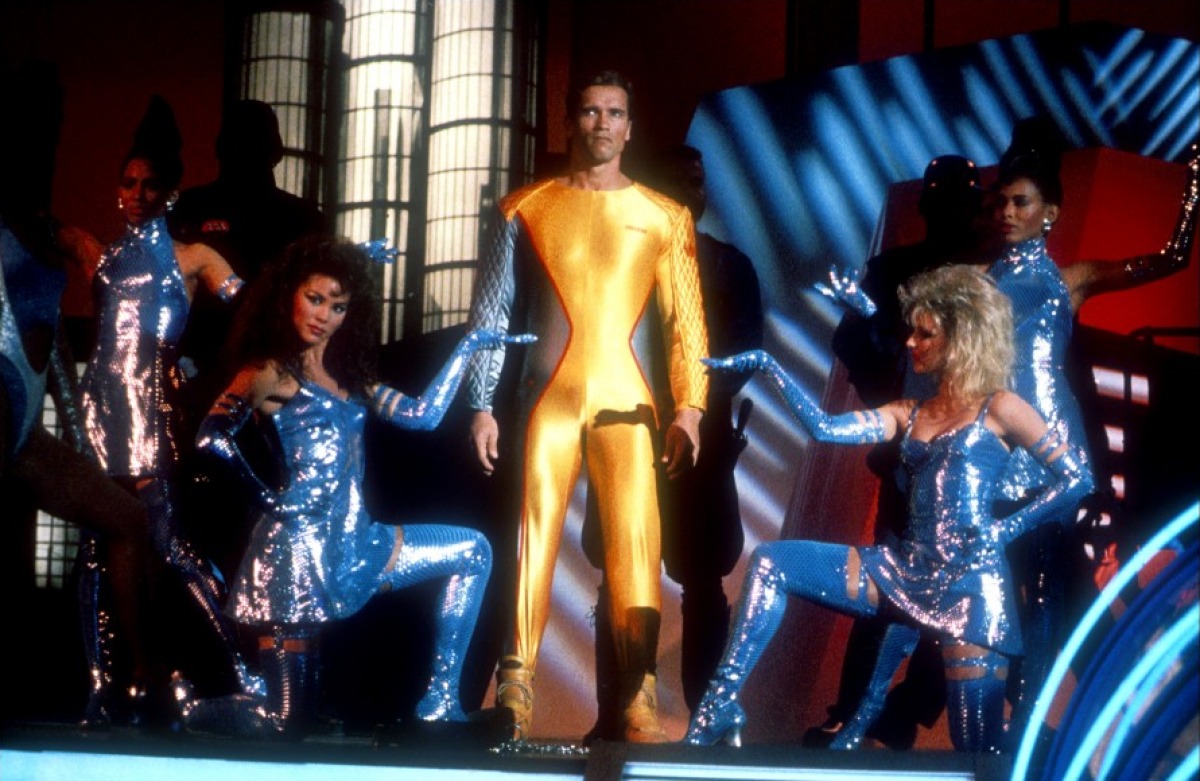Paul Michael Glaser’s The Running Man (1987) isn’t just a neon-soaked, hyper-violent slice of late-’80s sci-fi mayhem—it’s a razor-edged satire about state propaganda, media distortion, and the way entertainment turns into a weapon when wielded by authoritarian power. On the surface, it plays as a pulpy thriller about a falsely accused man forced to survive a lethal, televised bloodsport.
But beneath that glossy veneer lies a scathing critique of how truth is manufactured, how audiences are conditioned to cheer on brutality, and how a narrative repeated loudly and often enough can sculpt public perception—deciding who becomes a hero, who becomes a villain, and who gets erased entirely.
Spoilers Ahead
The Running Man (1987) Plot Summary and Movie Synopsis
By 2017, America had collapsed into a totalitarian state. The economy has failed, resources are scarce, and the government maintains control by censoring the arts, criminalizing dissent, and pumping out propaganda through ICS, the state-run network. Its crown jewel is “The Running Man,” a game show where prisoners are hunted by government-employed “stalkers.’ If they survive, they win their freedom, or so the public is led to believe.
Who is Ben Richards?
Captain Ben Richards begins as a police helicopter pilot ordered to fire on civilians rioting for food in Bakersfield. Richards refuses, recognizing that the crowd is unarmed. His fellow officers massacre the crowd anyway and frame him. ICS quickly brands him “The Butcher of Bakersfield.” His refusal to obey immoral orders marks him as a liability to a system built on violence, so the government does what it does best: it rewrites the truth.
Eighteen months later, Richards escapes a prison labor camp with two resistance fighters, Harold Weiss and William Laughlin. They want Richards to join their cause, but at this stage, Richards is a man focused on survival, not ideology. He doesn’t want to be a revolutionary. He just wants a life where he’s not hunted like an animal.
Who is Amber Mendez?
Richards seeks refuge at his brother’s old apartment, where he meets Amber Mendez, a musician working for ICS. She believes the government’s version of the Bakersfield massacre, that Richards killed dozens of civilians. When Richards forces her to help him bypass airport security, she panics and reports him. But then she sees ICS broadcast newly “recovered’ footage showing Richards killing people in Bakersfield, footage she knows is fabricated. This is the seed of her transformation. Once she notices one lie, the entire system begins to unravel in front of her.
Damon Killian, the charismatic yet ice-cold host of The Running Man, sees Richards differently: not as a criminal, but as ratings gold. Killian understands the audience’s hunger for spectacle. The more outrageous the villain, the bigger the viewership. Richards’s escape makes him a perfect contestant.
Killian blackmails him: Run in the game show…or your resistance friends will be forced into the arena instead. Richards reluctantly agrees, only to be betrayed. Not only is he sent into the deadly zone, but Weiss and Laughlin are blasted in with him. This betrayal sets the tone for the entire movie: in a world where the government manipulates everything, even the rules designed to save your life are lies.
Why Does Ben Richards Become a Symbol for the Audience?
Richards, Weiss, and Laughlin are launched into the game zone, an abandoned, war-torn section of Los Angeles. Their first stalker is Subzero, a hockey-themed murderer armed with explosive pucks and a razor-sharp stick. Richards defeats him. It’s the first time in the show’s history that a runner has killed a stalker.
This instantly changes Richard’s relationship with the audience. For the first time, viewers see a runner not as prey, but as a fighter. His survival challenges the myth that stalkers are invincible, and cracks begin forming in the narrative ICS feeds the public. Meanwhile, Amber is caught trying to retrieve the original Bakersfield footage, hoping to prove Richards is innocent. Instead of investigating, ICS sends her into the game. Her punishment sends a chilling message to viewers: searching for the truth is a crime.
Killian escalates the violence by sending Buzzsaw and Dynamo next. Buzzsaw, chainsaw-wielding and theatrically sadistic, embodies the show’s appeal. He’s cruel enough to keep the audience engaged. Richards kills Buzzsaw but loses Laughlin in the fight. Dynamo kills Weiss shortly after. Before dying, Weiss reveals that the resistance has discovered the government’s satellite uplink, the heart of ICS’s control, and gives Amber the access codes.
Richards later defeats Dynamo but refuses to kill him while he’s defenseless. This moral stance shocks the audience more than the violence. Viewers expect mindless brutality. Instead, Richards shows conscience, something their government has taught them doesn’t exist in criminals. This moment becomes a critical turning point: the public starts to root for Richards.

Why Does Amber Become the Key to Exposing ICS?
Amber’s transformation is subtle but essential. She begins as a believer, trusting ICS and the government. Amber witnesses a lie, footage proving Richards committed crimes he didn’t. Furthermore, Amber searches for the truth and is punished for it. She learns the system is rigged, discovering that the supposed past winners are dead.
Amber embodies the ordinary citizen who is forced to confront the truth. Her arc matters because it mirrors the awakening the audience must experience. It’s Amber who retrieves, memorizes, and ultimately helps broadcast the uplink codes, making her the bridge between Richards’s fight and the resistance’s mission.
Why is Damon Killian the Real Villain?
Killian isn’t just a TV host; he is the regime’s spokesman. He wears a smile like a mask, hiding the fact that everything on ICS is engineered to keep people docile. Killian’s goal isn’t to kill Richards. It’s to control the narrative around him. He offers Richards a job as a stalker, an attempt to turn a man with a conscience into another weapon for ratings.
When Richards refuses, Killian does what the government always does: he lies. He forces retired stalker Captain Freedom to film a fake fight scene, then broadcasts manipulated footage that shows Freedom killing Richards and Amber. This helps the government maintain the illusion that the game is fair, the stalkers are mighty, and resistance is hopeless. Killian isn’t trying to defeat a man; he’s trying to crush hope.
The Running Man (1987) Movie Ending Explained:
How Does Ben Richards Turn a Game Show Into a Revolution?
Once the doctored footage airs, Richards realizes the terrifying truth: The government must ensure he and Amber are never seen alive again. They are no longer playing a game. They are being erased. Richards and Amber join resistance leader Mic, who has been preparing to use the satellite uplink to bypass ICS and show the nation the truth. With Amber’s memorized code, the resistance finally breaks through.
They hack ICS and broadcast the unedited Bakersfield footage, proof that Richards was framed, evidence that past winners were murdered, and confirmation that ICS manipulates everything from footage to election results. The public, for the first time in years, sees truth unfiltered. The lies crumble. Dynamo attempts a final attack on Amber, but she activates the sprinkler system – and the electricity kills him. It’s symbolic: the government’s weapon is undone by its own tools.
On the other hand, Richards storms ICS, fighting through guards as terrified audience members flee the collapsing illusion of safety. He corners Killian on set, forcing him into the same rocket sled used for contestants. Killian rockets into the game zone. The controlled track malfunctions, the sled crashes, and he dies in an explosion. Killian dies the way he lived, i.e., inside his own spectacle as the broadcast shuts down and crowds celebrate, Richards and Amber kiss.
Richards never intended to lead an uprising. He simply refused to kill innocent civilians. His ‘crime’ was conscience. It’s the very trait the government tries to erase from society. By forcing him into “The Running Man,” the regime hoped to humiliate and destroy him. Instead, they created a symbol of defiance.
The movie repeatedly shows how: news is manipulated, footage is faked, winners are murdered, crimes are invented, and spectacles replace truth. Once ICS loses control of the image, it loses control of the people. The audience begins as bloodthirsty spectators, cheering death. But Richards shows them something they didn’t expect: mercy, integrity, and humanity. These qualities destabilize the system more than guns ever could.
Killian isn’t just a villain – he’s a warning. His death isn’t justice. It’s irony. He built a world where stories matter more than lives. But the moment his own story slips out of his control, he dies inside the machinery he created. “The Running Man” ultimately is about truth. Ben Richards wins not because he’s the strongest fighter, but because he refuses to let the government define him.
The film exposes how authoritarian states weaponize entertainment, manipulate news, and turn citizens into spectators of their own oppression. But it also argues that one genuine, unfiltered truth, broadcast at the right moment, can bring the whole system crashing down. Richards doesn’t escape the game. He destroys it. And in doing so, he gives the people something they haven’t had in years: a story worth believing.

![Matter Out of Place [2022]: ‘Locarno’ Review – We Have A Serious Garbage Problem!](https://79468c92.delivery.rocketcdn.me/wp-content/uploads/2022/08/Matter-Out-of-Place-2022-768x416.jpg)



